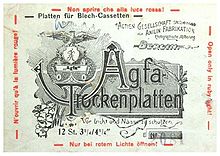Photo plate
A photo plate is a plate made of metal or glass coated with a photo emulsion . Examples of metal plate methods are heliography by Niépce , the daguerreotype and the photogravure .
History and Development
Glass was the first available carrier material for photo emulsions. It was only with the invention of the celluloid that the production of photographic films became possible. Films are lighter and can, for. B. as roll film , handle much better than photo plates. In addition, the risk of breakage of photo plates should not be neglected. So the photo plate has been superseded by almost all areas of photography.
It was only used where the advantages of the photo plate, namely dimensional stability, flatness and resistance to environmental influences , continued to be used, for example in high-precision special cameras for photogrammetric and astronomical recordings.
Methods of making photographic plates included heliography , daguerreotype , collodion wet plate, and gelatin dry plate .
Plate formats of around 5 × 7 cm to around 24 × 30 cm are typical for plate cameras, and larger for special purposes. The transparent plates made of 1 to 2 mm thick clear glass are also exposed with the layer side facing the imaging optics (hole, lens or lens system). In order to reduce courtyards around the “lights” of the motif, the gelatine layer itself can be colored to absorb light.
Positive paper images are then typically created by contact printing, i.e. plate negative - with the layer side - placed on photo paper and exposed from above with a lamp.
Astrophotography
In astrophotography , photo plates enable images of larger fields of the starry sky to be measured precisely and economically. The observatory founded by Cuno Hoffmeister in Sonneberg , Thuringia, has one of the world's largest photo plate archives . As part of the Sonneberg Field Plan , more than 11,000 variable stars have been discovered on photo plates so far . However, with the availability of ever larger CCD sensors, photo plates are becoming less important in astronomy .
They were also used as detectors in mass spectrometers . There, however, they did not detect photons , but ions . In this application they have already been displaced by other detectors such as secondary electron multipliers and Faraday cups .
Picture example
- Photo plate, 9x12 cm, showing the Djurgårdsbrunnskanalen in Stockholm in the winter of 1905
See also
- Recording formats of photographic plates
- Gradation , Schwarzschild effect
- Aerial photo measurement , mono and stereo comparator
literature
- Wolfgang Autenrieth: New and old techniques of etching and fine printing. From witch's meal and dragon's blood to the photopolymer layer. Tips, tricks, instructions and recipes from five centuries. (An alchemical workshop book for erasers). Version 6.3. W. Autenrieth, Krauchenwies 2010, ISBN 978-3-00-035619-3 ( table of contents , (→ excerpts online) )
- Peter Kroll, Constanze La Dous, Hans-Jürgen Bräuer: Treasure Hunting in Astronomical Plate Archives. (Proceedings of the international Workshop held at Sonneberg Observatory, March 4 to 6, 1999.) Verlag Harri Deutsch, Frankfurt am Main (1999), ISBN 3-8171-1599-7 .
Web links
- Experiments with plate scans from Sonneberg (by Béla Hassforther)
- http://www.glasnegativ.de/ An online gallery with old photo plates from various photographers.
- Historical recipes for emulsions of plate coatings for photographic and printing purposes





